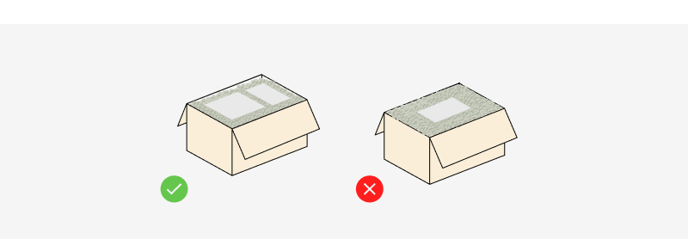Packaging guide: How do I pack my goods correctly?
Not sure how to pack your goods? This article has three segments that give you tips on how to package your goods depending on whether you are sending packages, pallets or "irregular goods".
⏱ 4 minutes reading time
Parcels
- Use high quality packaging without any damages
- If reusing packaging, remove all old shipping documents and labels.
- The goods can not be in direct contact with the box, use some form of filling material to protect your goods
- The packaging must be completely filled to reduce the risk of damage
- Goods over 35 kg must be sent on a pallet
- If you are sending liquids, your goods must be carefully sealed in absorbent material and enclosed in a tight plastic bag. Liquids easily damage other packages if they are not packaged properly. If this is not packaged properly, the carrier can also decide to deny a claim based on the packaging
Important: TNT, UPS and FedEx can handle packages up to 70 kg without it standing on a pallet. DHL and DSV take nothing over 35 kg without a pallet.
A guide to stronger packaging
1. Choose quality
Used cardboard boxes lose their strength. Make sure that the cardboard is of rigid material and in good condition.

2. Avoid empty spaces
Too much filler reduces stability when stacking. Avoid packages that are too large for their contents - they risk being crushed.

3. Tape the box to form an H with the tape
Use proper sealing tape in an H pattern on both the top and bottom. Also use string/straps around heavier packages.

Pallet
- If your pallet contains packages, look at the guide on how to pack packages above.
- If your pallet contains several packages, stack these in rows, preferably with some kind of disc between each layer. This increases stability.
- If you pack goods in several layers on your pallet, make sure that the heaviest goods end up at the bottom and then build on with lighter and lighter goods.
- Pack the pallet without overhang. Make sure that all goods fit on the pallet.
- If possible, flatten the top of the pallet.
- Secure the goods on the pallet. Use plastic or metal tape and / or stretch film. The pallet should function as one unit.
A guide to perfectly packed pallets
1. Stack in rows, preferably with a board between each layer.
Rows ensure maximum stacking strength. If the contents are rigid, you can use the "brick technique" for added stability.

2. Avoid overhangs
We accept pallets with overhangs but as these can easily be damaged or damage other shipments, we prefer and recommend shipments that fit on the pallet.

3. Make sure the top is flat
A flat top makes the pallet strong, compact and stackable. Pallets that are not stackable are subject to a charge.

4. Banding or wrapping the pallet
Use plastic or metal straps and/or stretch film to hold the goods in place on the pallet. The stretch film should cover the entire pallet.

Irregular goods
If you send heavier pipes / cylinders, these must be fastened to a pallet
Lighter tube-shaped objects can be sent in triangular boxes. This is so that they will not be able to roll.
Unpackaged items must be fastened to a pallet. Then make sure to cover the object with a wooden frame or an upside down box. Use padding to protect sharp edges that can be exposed.
A guide for irregularly shaped mail items
1. Tubes
Heavy cylinders should be strapped to a pallet. Avoid overhangs and make sure the pallet is stackable. Lighter tubular items can be packed in a triangular trasnport tube.

2. Unpacked articles
Unpacked items should be wrapped and/or strapped to a pallet. Use extra padding to cover any sharp edges that may be exposed.

3. Sharp/protruding articles
Sharp items should be wrapped in protective material before being placed in a carton. Never allow anything to protrude from a package as the shipment may be damaged when stacked. If necessary, use a larger carton or a pallet.

Did we not answer all your questions?
Drop us a message in the chat and we will help you! 🌟